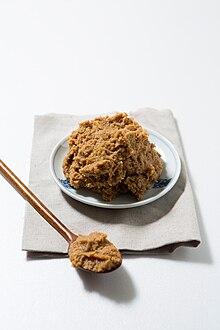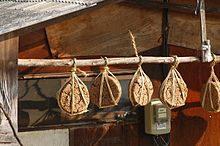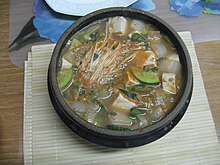Doenjang
 | |
| Alternative names | Soybean paste |
|---|---|
| Type | Fermented bean paste |
| Place of origin | Korea |
| Region or state | East Asia |
| Main ingredients | Soybean,brine |
| Other information | Brewed along withganjang |
| Korean name | |
| Hangul | 된장 |
|---|---|
| Hanja | 된 tương |
| Revised Romanization | doenjang |
| McCune–Reischauer | toenjang |
| IPA | [tøn.dʑaŋ] |
 |
| This article is part of a series on |
| Korean cuisine 한국 요리 조선 료리 |
|---|
Doenjang[1](Korean:된장;"thick sauce" ) orsoybean paste[1]is a type offermented bean paste[2]made entirely ofsoybeanandbrineused inKorean cuisine.It is also a byproduct ofsoup and soy sauceproduction. It is sometimes used as arelish.[2]
History
[edit]The earliest soybean fermentations inKoreaseem to have begun prior to the era of theThree Kingdoms.[3]TheRecords of the Three Kingdoms,aChinesehistorical text written and published in the third century AD, mentions that "Goguryeopeople are good at brewing fermented soybeans "in the section namedDongyi(Eastern foreigners)in theBook of Wei.[4][5]Jangdoksused for doenjang production are found in themuralpaintings ofAnak Tomb No. 3from the 4th centuryGoguryeo.[6]
InSamguk Sagi,a historical record of the Three Kingdoms era, it is written thatdoenjangandganjang,along withmejuandjeotgal,were prepared for thewedding ceremonyofKing Sinmunin February 683.[7]Sikhwaji,a section fromGoryeosa(History of Goryeo),recorded thatdoenjangandganjangwere included in the relief supplies in 1018, after aKhitan invasion,and in 1052, when afamineoccurred.[8]Joseontexts such asGuhwangchwaryoandJeungbo sallim gyeongjecontain detailed procedures on how to brew good-qualitydoenjangandganjang.[3]Gyuhap Chongseoexplains how to pick a date for brewing, what to forbear, and how to keep and preservedoenjangandganjang.[7]
Production
[edit]
Doenjangis made entirely of fermented soybean and brine.Soup soy sauceis also made during thedoenjangproduction.
Meju,Koreansoybeanbrick, is made aroundipdongin early November. Soybeans are soaked overnight, boiled insalt water,and then pounded in a mortar (jeolgu) or coarsely ground in amillstone.About adoe(≈1.8litres) or twodoes of pounded soybean is chunked, compressed, and shaped into a cube or a sphere calledmeju.Themejubricks are then dried in a cool, shaded area for a week to several weeks until firm. When the bricks harden, they are tied withrice strawsto theeavesof the house, or put in the warmondolroom with rice straws, forfermentation.InJeongwol,the first month of thelunar year,well-fermentedmejubricks are washed andsun-dried.
After drying, themejubricks are aged inonggicrocks (jangdok) with brine. Charcoal and chillies are added for their absorbent and antibacterial properties, as well as folk-religious beliefs that they drive evil spirits away. When fermented well, the agedmejuchunks are mashed to becomedoenjang,and the filtrate is boiled to becomeganjang.
Types
[edit]Thoughdoenjangandganjangare usually made together,doenjangcan also be made without producing any filtrate.
- Tojang(Korean:토장) – When the aged brine is boiled to becomeganjang,the rest (agedmejuchunks) are mashed to becometojang.
- Jangjae(Korean:장재) – Smaller amount of brine is used from the beginning. No soy sauce is produced in the process, and themejuaged with the smaller amount ofbrinebecomesjangjae,another type ofdoenjang.
While traditionaldoenjangis made with soybeans and brine only, many factory-made variants ofdoenjangcontain a fair amount of wheat flour just like most factory-made soy sauce does. Some current makers also add fermented, dried, and groundanchoviesto accentuatedoenjang's savory flavor.Korean Ministry of Food and Drug Safety'sFood Codeclassifiesdoenjanginto three categories by their ingredients.[9][10]
- Hansik-doenjang(Korean:한식된장,"Korean-style fermented soybean paste" ) –doenjangmade with traditional stylemejuand brine.
- Doenjang(Korean:된장,"fermented soybean paste" ) –doenjangmade with non-traditionalmeju(which can be made ofsoybean,rice,barley,wheatordegreased soybean,and ripened using traditional method orAspergillus) and saline solution.
- Seasoned doenjang(Korean:조미된장) – product that contains more than 90% ofdoenjangorhansik-doenjang.
Use
[edit]
Doenjangcan be eaten as a condiment in raw-paste form with vegetables, as flavored seasoning or even as a dipping condiment. However, it is more commonly mixed with garlic,sesame oil,and sometimesgochujangto producessamjang,which is then traditionally eaten with or without rice wrapped inleaf vegetablessuch as red leaf lettuce. This dish is calledssambap.This combination of leaf vegetable anddoenjang(orssamjang) often complements popular Korean meat dishes such assamgyeopsal,bulgogi,bibimbapandBoss am.
It can also be used as a component of soup broth, as in the popular stewdoenjang jjigae,which usually includestofu,various vegetables such aschile peppers,zucchini,andscallion,and (optionally)mushrooms,red meat,orscallops.
Nutrition and health
[edit]Doenjangis rich inflavonoidsand beneficial vitamins,minerals,andplant hormones(phytoestrogens) which are sometimes claimed to possess anticarcinogenicproperties.[11]In Korean traditional meals, the menu has concentrated on vegetables and rice, butdoenjang,which is made of soybeans, has a great deal of lysine, an essential amino acid that rice lacks.Linoleic acid(53% of the fatty acids) andlinolenic acid(8% of the fatty acids) have an important role in normal growth of blood vessels and prevention of blood vessel-related illness.Doenjang's efficacy still exists after boiling, in dishes such asdoenjang jjigae.[12]
Claims are being explored about the role ofdoenjangin reducing visceral fat, though most studies have only been done on rodents.[13]However, one study on humans does exist, which suggests that its visceral fat reduction properties are also present in humans.[14]
Outside Korea
[edit]Doenjangis considered one of the essential sauces of authentic Korean cuisine. However, the condiment has historically been unknown outside of Korea, although recent international articles have resulted in an increase in its popularity. A 2007 Chinese article on the "Sauces of Korea" listeddoenjangandgochujangas essential flavorings, and explored the origins of the condiments, particularly focusing onSunchang County,where most Korean soy sauce is produced. The article pointed out thatdoenjangdoes not contain any artificial additives and in fact has healthy amounts of essential vitamins, such asvitamin Candvitamin B12.The health benefits ofdoenjangare rumored to extend longevity, and this is illustrated by the fact that out of the 32,000 people in Sunchang County, eight are over 100 years old, and many are over 90. The article was influential throughout China, resulting in many Chinese restaurants addingdoenjang jjigaeto their menus shortly after publication. South Korea'sJoongAng Ilbocovered this story in China on December 13, 2007.[15]
In culture
[edit]"Doenjanggirl"is a slang term for women who indulge in luxurious products to show off despite not being able to afford them, and eat low-priced basic food at home.[16]
See also
[edit]- Cheonggukjang
- Dou gian g,fresh soy milk in Chinese cuisine
- Fermented bean paste
- Korean cuisine
- List of condiments
- List of fermented foods
- List of fermented soy products
- Miso
- Nattō
- Tương
- Yellow soybean paste
References
[edit]- ^ab(in Korean)"주요 한식명(200개) 로마자 표기 및 번역(영, 중, 일) 표준안"[Standardized Romanizations and Translations (English, Chinese, and Japanese) of (200) Major Korean Dishes](PDF).National Institute of Korean Language.2014-07-30.Retrieved2017-02-24.
- 주요 한식명 로마자 표기 및 표준 번역 확정안 공지.National Institute of Korean Language(Press release) (in Korean). 2014-05-02.
- ^abHolland, M. (2015).The World on a Plate: 40 Cuisines, 100 Recipes, and the Stories Behind Them.Penguin Publishing Group. p. 221.ISBN978-0-698-19406-9.RetrievedNovember 3,2017.
- ^ab강, 명기 (20 October 2006)."항암효과가 탁월한 우리의 구수한 된장"[Our flavourful doenjang with potent antitumor effect].Dailian(in Korean).Retrieved6 December2016.
- ^황, 광해 (9 January 2013)."바람이 말리고 세월이 삭힌 깊은 맛"[Deep flavour, dried by wind and fermented by time].Weekly Hankook(in Korean).Retrieved6 December2016.
- ^Koo, Chun-Sur (Spring 2004)."Ganjang and Doenjang: Traditional Fermented Seasonings"(PDF).Koreana.Vol. 18, no. 1. The Korea Foundation. Archived fromthe original(PDF)on 9 November 2016.Retrieved6 December2016.
- ^신, 동민 (9 November 2015)."행복을 부르는 맛 '간장'…집에서 만든 만능간장소스 하나면 OK"[Ganjang, the flavour that brings happiness... Home-made versatile ganjang sauce is all you need].Maekyung Economy.No. 1831.Retrieved6 December2016.
- ^ab하, 상도 (11 January 2016)."신라시대에 왕비 폐백품목에도 있었던 식품은?"[Guess what food was used for pyebaek ceremony of a Silla queen].Chosun pub(in Korean). Archived fromthe originalon 25 January 2016.Retrieved6 December2016.
- ^김, 성윤 (19 January 2012)."정월에 담근 장이 가장 맛있다는데…"[Jang tastes the best when made in the first month of the year (in the Lunar calendar)].The Chosun Ilbo(in Korean).Retrieved6 December2016.
- ^"Food_Code(No.2015-4_20150203)".mfds.go.kr.MFDS - Ministry Of Food And Drug Safety. 3 February 2015.Retrieved6 December2016.
- ^"식품공전 (제 5. 식품별 기준 및 규격 / 20. 장류)"[Food Code (Article 5. Standards and Specifications for Each Food Product / 20. Soy Sauces or Pastes)].foodsafetykorea.go.kr(in Korean). 식품의약품안전처 식품안전정보포털. 30 September 2016.Retrieved6 December2016.
- ^Prof. Kun-Young Park,Pusan National University(2005-10-26)."Korean food for defeating cancer"(in Korean).Hankook Ilbo.Archived fromthe originalon 2008-05-10.Retrieved2007-11-26.
- ^Prof. Suk Ja, YoonBaewha Women's College(2004-04-16)."Efficacy and Nutrition of Doenjang"(in Korean). Public website. Archived fromthe originalon 2011-07-18.Retrieved2008-01-21.
- ^Shil Kwak, Chung; Chul Park, Sang; Yong Song, Kye (2012). "Doenjang, a Fermented Soybean Paste, Decreased Visceral Fat Accumulation and Adipocyte Size in Rats Fed with High Fat Diet More Effectively Than Nonfermented Soybeans".Journal of Medicinal Food.15(1): 1–9.doi:10.1089/jmf.2010.1224.PMID22082067.
- ^Cha, YS; Yang, JA; Back, HI; Kim, SR; Kim, MG; Jung, SJ; Song, WO; Chae, SW (2012)."Visceral fat and body weight are reduced in overweight adults by the supplementation of Doenjang, a fermented soybean paste".Nutr Res Pract.6(6): 520–6.doi:10.4162/nrp.2012.6.6.520.PMC3542442.PMID23346302.
- ^"JOINS | 아시아 첫 인터넷 신문".Archived fromthe originalon 2010-09-09.Retrieved2008-01-21.
- ^실사로 보는… '이것이 된장녀의 하루!'The Hanguk 2007/02/13
External links
[edit]- Different ways of consuming Doenjang (video)
- Photo of South Korea-produceddoenjang
- The history ofdoenjang
- Prof. Kun-Young Park,Pusan National University."Longer aging time increases the anticancer and antimetastatic properties of doenjang"(in Korean). ASA-IM Korea. Archived fromthe originalon 2007-12-05.Retrieved2007-11-26.
- "Regional doenjang"(in Korean). The Rural Development Administration of South Korea. Archived fromthe originalon May 31, 2008.Retrieved2007-11-26.

